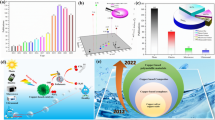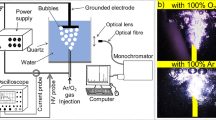Abstract
A microwave (MW) heat-activated the persulfate (PS) process was employed to treat paracetamol (PAM) in wastewater, and the powder-activated carbon (PAC) be used is used as a catalyst to accelerate this reaction process. The PAM added (100 mg) to the solution was nearly completely removed within 70 min, and the PH, temperature, PAC, and PS dosage have great influence on the degradation process; the total organic carbon (TOC) removal rate reached 98%. The PAC1 still had a good catalytic effect after being reused six times. The radical mechanism was investigated to determine the type of dominant active species involved in PAM degradation. Sulfate radicals (\( {\mathrm{SO}}_4^{-\bullet } \)) were the dominant oxidizing agent for PAM degradation under acidic conditions. The degradation mechanism was proposed based on the PAM degradation intermediates, which were identified using ultra-high-performance liquid chromatography coupled with linear trap quadrupole orbitrap mass spectrometry. Three types of possible reaction pathways for PAM were identified as follows: including hydroxylation of the benzene ring, amine group oxidation at the benzene ring, and amine (HN–C=O) functional group N–C bond cleavage.









Similar content being viewed by others
References
Aburub, A., & Wurster, D. E. (2006). Phenobarbital interactions with derivatized activated carbon surfaces. Journal of Colloid & Interface Science, 296, 79.
Al-Shamsi, M. A., & Thomson, N. R. (2013). Competition by aquifer materials in a bimetallic nanoparticle/persulfate system for the treatment of trichloroethylene. Environmental Science Processes & Impacts, 15, 1964–1968.
Álvarez-Torrellas, S., Peres, J. A., Gil-Álvarez, V., Ovejero, G., García, J. (2017). Effective adsorption of non-biodegradable pharmaceuticals from hospital wastewater with different carbon materials. Chemical Engineering Journal.
An, D., Westerhoff, P., Zheng, M., Wu, M., Yang, Y., & Chiu, C. A. (2015). UV-activated persulfate oxidation and regeneration of NOM-saturated granular activated carbon. Water Research, 73, 304.
Arredondo Valdez, H. C., García, J. G., Gutiérrez, G. S., & Ponce, D. L. C. (2012). Degradation of paracetamol by advance oxidation processes using modified reticulated vitreous carbon electrodes with TiO2 and CuO/TiO2/Al2O3. Chemosphere, 89, 1195–1201.
Benitez, F. J., Beltran-Heredia, J., Torregrosa, J., & Acero, J. L. (2015). Treatment of olive mill wastewaters by ozonation, aerobic degradation and the combination of both treatments. Journal of Chemical Technology & Biotechnology, 74, 639–646.
Bruton, T. A., & Sedlak, D. L. (2018). Treatment of perfluoroalkyl acids by heat-activated persulfate under conditions representative of in situ chemical oxidation. Chemosphere, 636, 355–359.
Chawla, O. P., & Fessenden, R. W. (1975). Electron spin resonance and pulse radiolysis studies of some reactions of peroxysulfate (SO4.1,2). Journal of Physical Chemistry, 79, 2693–2700.
Cheng, S., Wu, J., Xia, H., Peng, J, Wang, S. X., Zhang, L. (2012). Microwave-assisted regeneration of spent activated carbon from paracetamol wastewater plant using response surface methodology. Desalination & Water Treatment 1–11.
Contreras, E., Sepúlveda, L., & Palma, C. (2012, 2012). Valorization of agroindustrial wastes as biosorbent for the removal of textile dyes from aqueous solutions. International Journal of Chemical Engineering, (2012-5-8), 2012.
Corey, E. J., Czakó, B., & Kürti, L. (2007). Molecules and medicine. John Wiley & Sons.
Criquet, J., & Leitner, N. K. V. (2009). Degradation of acetic acid with sulfate radical generated by persulfate ions photolysis. Chemosphere, 77, 194–200.
Dasary, S. S. R., Saloni, J., Fletcher, A., Anjaneyulu, Y., & Yu, H. (2010). Photodegradation of selected PCBs in the presence of nano-TiO2 as catalyst and H2O2 as an oxidant. International Journal of Environmental Research & Public Health, 7, 3987–4001.
Devi, P., Das, U., & Dalai, A. K. (2016). In-situ chemical oxidation: principle and applications of peroxide and persulfate treatments in wastewater systems. Science of the Total Environment, 571, 643–657.
Dogliotti, L., Hayon, E. (1967). Flash photolysis of per[oxydi]sulfate ions in aqueous solutions. The sulfate and ozonide radical anions. Journal of Physical Chemistry, 71.
Fanxiaoyan. (2017). [APIs] Domestic enterprises of 15 powerful countries in the world account for 9 seats: market competition is fierce and export efficiency is difficult to increase in the short term [EB/OL]. Guangdong: Medicine Economic News [2017.12.19]. https://wenda.so.com/q/1368298985066435.
Fatta-Kassinos, D. (2010). K. Kümmerer, pharmaceuticals in the environment: sources, fate, effects and risks. Environmental Science & Pollution Research, 17, 519–521.
Ghoshdastidar, A. J., Fox, S., & Tong, A. Z. (2015). The presence of the top prescribed pharmaceuticals in treated sewage effluents and receiving waters in Southwest Nova Scotia, Canada. Environmental Science & Pollution Research, 22, 689.
González, O., Sans, C., & Esplugas, S. (2007). Sulfamethoxazole abatement by photo-Fenton toxicity, inhibition and biodegradability assessment of intermediates. Journal of Hazardous Materials, 146, 459–464.
Hayon, E., Treinin, A., & Wilf, J. (1972). Electronic spectra, photochemistry, and autoxidation mechanism of the sulfite-bisulfite-pyrosulfite systems. SO2−, SO3−, SO4−, and SO5− radicals. Journal of the American Chemical Society, 94, 47–57.
House, D. A. (1962). Kinetics and mechanism of oxidations by peroxydisulfate. Chemical Reviews, 62, 185–203.
Huang, X., An, D., Song, J., Gao, W., Shen, Y. (2017). Persulfate/electrochemical/FeCl2 system for the degradation of phenol adsorbed on granular activated carbon and adsorbent regeneration. Journal of Cleaner Production, 165.
Huie, R. E., Clifton, C. L., & Neta, P. (1991). Electron transfer reaction rates and equilibria of the carbonate and sulfate radical anions. International Journal of Radiation Applications & Instrumentation.part C.radiation Physics & Chemistry, 38, 477–481.
Huling, S. G., Ko, S., Park, S., & Kan, E. (2011). Persulfate oxidation of MTBE- and chloroform-spent granular activated carbon. Journal of Hazardous Materials, 192, 1484.
Jorge, M., Christian Schumacher, A., & Seaton, N. A. (2002). Simulation study of the effect of the chemical heterogeneity of activated carbon on water adsorption. Langmuir, 18, 9296–9306.
Kay, P., Hughes, S. R., Ault, J. R., Ashcroft, A. E., & Brown, L. E. (2016). Widespread, routine occurrence of pharmaceuticals in sewage effluent, combined sewer overflows and receiving waters ☆. Environmental Pollution, 220, 1447.
Kim, S. D., Cho, J., Kim, I. S., Vanderford, B. J., & Snyder, S. A. (2007). Occurrence and removal of pharmaceuticals and endocrine disruptors in South Korean surface, drinking, and waste waters. Water Research, 41, 1013–1021.
Kimura, M., & Miyamoto, I. (1994). Discovery of the activated-carbon radical AC+ and the novel oxidation-reactions comprising the AC/AC+ cycle as a catalyst in an aqueous solution. Bulletin of the Chemical Society of Japan, 67, 2357–2360.
Kolpin, D. W., Furlong, E. T., Meyer, M. T., Thurman, E. M., Zaugg, S. D., Barber, L. B., & Buxton, H. T. (2002). Pharmaceuticals, hormones, and other organic wastewater contaminants in U.S. streams, 1999-2000: a national reconnaissance. Environmental Science & Technology, 36, 1202–1211.
Kolthoff, I. M. (1947). Titration methods : acid-base, precipitation, and complex-formation reactions.
Leyva, E., Moctezuma, E., & Noriega, S. (2012). Photocatalytic degradation of omeprazole. intermediates and total reaction mechanism. Journal of Hazardous Materials, 243, 130.
Li, W. C. (2014). Occurrence, sources, and fate of pharmaceuticals in aquatic environment and soil. Environmental Pollution, 187, 193–201.
Li, G., Zhang, X., & Lei, L. (2008). Degradation of aqueous p-nitrophenol by ozonation integrated with activated carbon. Industrial & Engineering Chemistry Research, 47, 6809–6815.
Liang, C., & Su, H. W. (2009). Identification of sulfate and hydroxyl radicals in thermally activated persulfate. Industrial & Engineering Chemistry Research, 48, 472–475.
Liang, C., Wang, Z. S., & Bruell, C. J. (2007). Influence of pH on persulfate oxidation of TCE at ambient temperatures. Chemosphere, 66, 106–113.
Minisci, F., Citterio, A., Giordano, C. (1983). ChemInform abstract: electron-transfer processes: peroxydisulfate, a useful and versatile reagent in organic chemistry. Cheminform, 14:no–no.
Neta, P., Madhavan, V., Zemel, H., & Fessenden, R. W. (1977). Rate constants and mechanism of reaction of sulfate radical anion with aromatic compounds. Chemischer Informationsdienst, 8, 163–164.
Neta, P., Huie, R. E., & Ross, A. B. (1988). Rate constants for reactions of inorganic radicals in aqueous-solution. Journal of Physical and Chemical Reference Data, 17, 1027–1284.
Phillips, P. J., Smith, S. G., Kolpin, D. W., Zaugg, S. D., Buxton, H. T., Furlong, E. T., Esposito, K., & Stinson, B. (2010). Pharmaceutical formulation facilities as sources of opioids and other pharmaceuticals to wastewater treatment plant effluents. Environmental Science & Technology, 44, 4910.
Qi, C., Liu, X., Lin, C., Zhang, X., Ma, J., Tan, H., & Ye, W. (2014). Degradation of sulfamethoxazole by microwave-activated persulfate: kinetics, mechanism and acute toxicity. Chemical Engineering Journal, 249, 6–14.
Quan, X., Zhang, Y., Chen, S., Zhao, Y., & Yang, F. (2007). Generation of hydroxyl radical in aqueous solution by microwave energy using activated carbon as catalyst and its potential in removal of persistent organic substances. Journal of Molecular Catalysis A Chemical, 263, 216–222.
Quesadapeñate, I., Julcourlebigue, C., Jáureguihaza, U. J., Wilhelm, A. M., & Delmas, H. (2012). Degradation of paracetamol by catalytic wet air oxidation and sequential adsorption - catalytic wet air oxidation on activated carbons. Journal of Hazardous Materials s, 221–222, 131–138.
Remya, N., & Lin, J. G. (2011). Current status of microwave application in wastewater treatment—a review. Chemical Engineering Journal, 166, 797–813.
Roberts, P. H., & Thomas, K. V. (2006). The occurrence of selected pharmaceuticals in wastewater effluent and surface waters of the lower Tyne catchment. Science of the Total Environment, 356, 143.
Stylidi, M., Kondarides, D. I., & Verykios, X. E. (2004). Visible light-induced photocatalytic degradation of acid Orange 7 in aqueous TiO2 suspensions. Applied Catalysis B Environmental, 47, 189–201.
Sui, Q., Huang, J., Deng, S., Yu, G., & Fan, Q. (2010). Occurrence and removal of pharmaceuticals, caffeine and DEET in wastewater treatment plants of Beijing, China. Water Research, 44, 417–426.
Sun, Y., Zhang, B., Zheng, T., & Wang, P. (2017). Regeneration of activated carbon saturated with chloramphenicol by microwave and ultraviolet irradiation. Chemical Engineering Journal, 320, 264–270.
Tan, C., Gao, N., Zhou, S., Xiao, Y., & Zhuang, Z. (2014). Kinetic study of acetaminophen degradation by UV-based advanced oxidation processes. Chemical Engineering Journal, 253, 229–236.
Villota, N., Lomas, J. M., & Camarero, L. M. (2016). Study of the paracetamol degradation pathway that generates color and turbidity in oxidized wastewaters by photo-Fenton technology. Journal of Photochemistry & Photobiology A Chemistry, 329, 113–119.
Wei, M. C., Wang, K. S., Lin, I. C., Hsiao, T. E., Lin, Y. N., Tang, C. T., Chen, J. C., & Chang, S. H. (2012). Rapid regeneration of sulfanilic acid-sorbed activated carbon by microwave with persulfate. Chemical Engineering Journal, 193–194, 366–371.
Xia, H., Peng, J., & Zhang, L. (2015a). Preparation of high surface area activated carbon from Eupatorium adenophorum using K2CO3 activation by microwave heating. Green Processing & Synthesis, 4, 299–305.
Xia, H., Wu, J., Xia, Y., Zhang, L., Peng, J., Wang, S., Zheng, Z., & Zhang, S. (2015b). Microwave assisted regeneration of spent activated carbon from petrochemical plant using response surface methodology. Journal of Porous Materials, 22, 137–146.
Yan, J., Lei, M., Zhu, L., Anjum, M. N., Zou, J., & Tang, H. (2011). Degradation of sulfamonomethoxine with Fe3O4 magnetic nanoparticles as heterogeneous activator of persulfate. Journal of Hazardous Materials, 186, 1398–1404.
Yuan, Y., Tao, H., Fan, J., & Ma, L. (2015). Degradation of p -chloroaniline by persulfate activated with ferrous sulfide ore particles. Chemical Engineering Journal, 268, 38–46.
Zhang, C., Ning, K., Zhang, W., Guo, Y., Chen, J., & Liang, C. (2013). Determination and removal of antibiotics in secondary effluent using a horizontal subsurface flow constructed wetland. Environmental Science Processes & Impacts, 15, 709–714.
Zwiener, C., & Frimmel, F. H. (2000). Oxidative treatment of pharmaceuticals in water. Water Research, 34, 1881–1885.
Funding
National Natural Science Foundation of China(21966019、21567013), Yunan Ten Thousand Talents Plan Young & Elite Talents Project(2018-73), and Extracurricular Science and Technology Innovation Fund Project of Kunming University of Science and Technology (2015YB004)
Author information
Authors and Affiliations
Corresponding authors
Additional information
Publisher’s Note
Springer Nature remains neutral with regard to jurisdictional claims in published maps and institutional affiliations.
Rights and permissions
About this article
Cite this article
Zhang, Q., Cheng, S., Xia, H. et al. Paracetamol Degradation Performance and Mechanisms Using Microwave-Assisted Heat-Activated Persulfate in Solutions. Water Air Soil Pollut 230, 271 (2019). https://doi.org/10.1007/s11270-019-4286-7
Received:
Accepted:
Published:
DOI: https://doi.org/10.1007/s11270-019-4286-7




